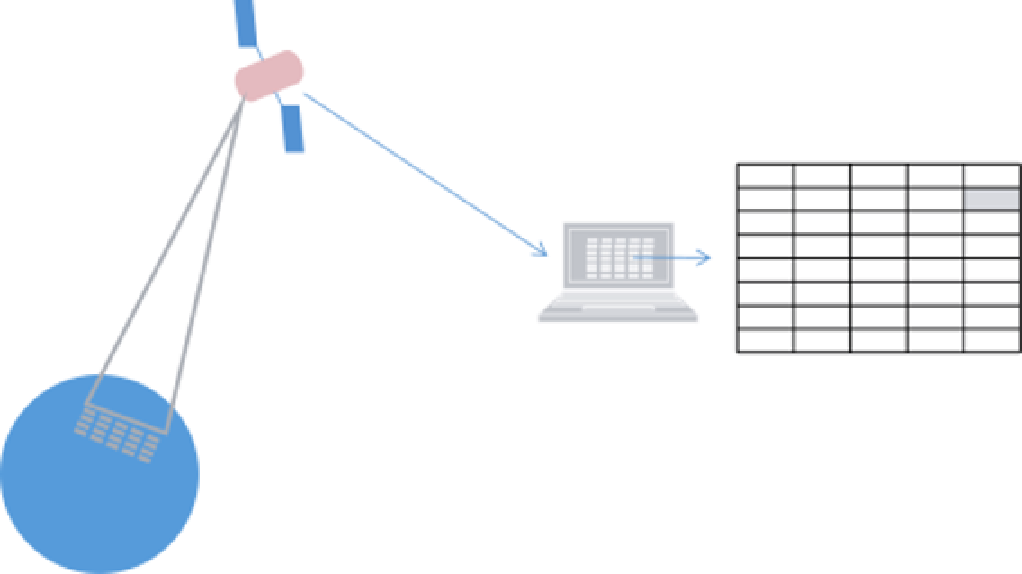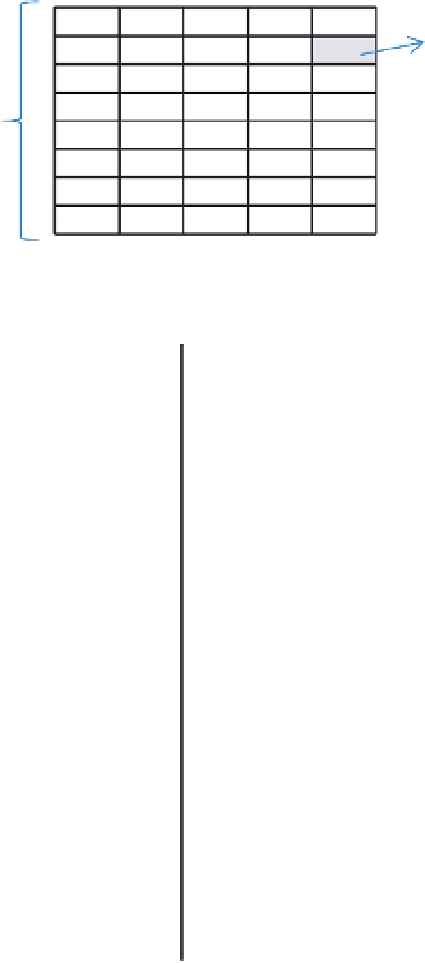Environmental Engineering Reference
In-Depth Information
222
175
222
175
175
332
175
332
40
40
322
40
322
40
40
222
40
222
222
222
222
222
222
222
222
40
40
175
175
175
175
40
40
40
40
222
222
332
322
222
FIGURE 22.1
Scanning the surface of the Earth.
222
175
222
175
175
332
175
332
40
40
322
40
322
40
pixel
222
222
222
222
40
222
40
222
222
222
222
Matrix
Row/column
40
40
175
175
175
175
40
40
40
40
222
222
332
322
222
FIGURE 22.2
Snapshot of remote sensed data for a given moment (T1) and a uniform scan spatial unit (SU).
analysis of dynamics of different phenomena required dynamic
''pixels'' self-aware of their 'value' in time-1, but also being
sensitive to change in time-2; being sensitive to its immediate
neighbors, or to specific action at a distance.
In order to perform analysis that included some of the previ-
ous needs, this would require more sophisticated pixel analysis,
linking it with the concepts of self-awareness, neighborhood
interaction (sensitivity to local conditions), but also sensitivity to
regional/global inference/interference. Consequently this would
mean allowing a ''pixel'' (and the matrix) to self-organize, to
change. These needs departed substantially from the traditional
pixel-matrix static concepts, and therefore, if these goals were
achievable, it would make sense to name this ''new pixel'' as a
''cell'' and the new kind of science dealing with all, the science of
complexity.
The founding fathers that are internationally recognized as
the ones contributing to the birth of the cell, self-organization,
and complexity are VonNeumann andMorgenstern (1944), Von
Neumann (1966)Ulam(1960, 1974), Prigogine (1999), Prigogine
and Stengers (1984) and Prigogine and Nicolis (1977), Tobler
(1979), Kauffman (1984, 1993), Wolfram (1994), Holland (1995,
1999), and Crutchfield and Mitchell (1995).
During the 1940s Von Neumann and Morgenstern's theory
of games and economic behaviour (1944) demonstrated that
it is indeterminism, probability, and discontinuous changes of
state that control the behaviour of most systems, in particular
the behaviour of the elements of systems and their contribution
to the overall patterns and processes in a system. Therefore,
the emphasis is in the representation and understanding of the
'behaviour of the elements'.
The proposal of cells as these new ''elements'' happened in the
1950s with joint work by Von Neumann's and Standislav Ulam
that linked game-theory and microbehavior, through the devel-
opment of a simple CA. CA provided local rules which could
generate mathematical patterns in two-dimensional and three
dimensional space. Therefore global order could be produced
from local action. A similar conclusion was found through the
observation of particles behaviour, Prigogine's work on molec-
ular interactions and the resulting large-scale spatial structure
demonstrated the importance of this micro-macro interaction in
pattern identification (Prigogine and Nicolis 1977; Prigogine and
Stengers, 1984; Prigogine, 1999).
By the 1950s the concept of cells as dynamic entities that
could be simulated in a computer gave rise to the CA. A com-
puter generated being, CA can be seen in its more primary
state, as a discrete model of spatiotemporal dynamics obeying
local laws.












Search WWH ::

Custom Search